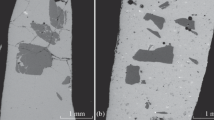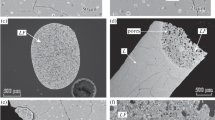Abstract
The lithium partitioning between aluminosilicate and alkaline aluminofluoride brine melts in a granite system with the limiting contents of water and fluorine has been studied experimentally at temperatures of 700–800°C and pressures of 100–500 MPa. It is shown that lithium is distributed into the brine melt under all conditions. An increase in the water content in the system by more than 20 wt % and a pressure from 100 to 500 MPa results in decrease in the lithium partition coefficients between brine and aluminosilicate melts by a factor of 2–4.






Similar content being viewed by others
REFERENCES
Alferyeva, Ya.O., Gramenitskii, E.N., and Shchekina, T.I., Experimental study of phase relations in a lithium bearing fluorine rich haplogranite and nepheline syenite system, Geochem. Int., 2011, vo. 49, no. 7, pp. 676–690.
Alferyeva, Ya.O., Shchekina, T.I., and Gramenitskiy, E.N., The limiting contents of fluorine and water in highly differentiated granite melts, Moscow Univ. Geol. Bull., 2018b, vol. 73, no. 4, pp. 390–396.
Andreeva, I.A., Kovalenko, V.I., Yarmolyuk, V.V., et al., Immiscibility of silicate and salt (Li,Na,F) melts in comendite at the Zaart Khudag ore occurrence, Central Mongolia: Evidence from melt inclusions, Dokl. Earth Sci., 2007, vol. 414, no. 1, pp. 655–660.
Badanina, E.V., Syritso, L.F., Volkova, E.V., et al., Composition of Li–F granite melt and its evolution during the formation of the ore-bearing Orlovka Massif in Eastern Transbaikalia, Petrology, 2010, vol. 18, no. 2, pp. 131–157.
Baker, D.R. and Alletti, M., Fluid saturation and volatile partitioning between melts and hydrous fluids in crustal magmatic systems: The contribution of experimental measurements and solubility models, Earth. Sci. Rev., 2012, no. 114, pp. 298–324.
Gramenitskiy, E.N., Shchekina, T.I., Berman, I.B., and Popenko, D.P., Lithium accumulation by aluminofluoride melt in the fluorine-bearing granite system, Dokl. Ross. Akad. Nauk, 1993, vol. 331, no. 1, pp. 87–90.
Gramenitskiy, E.N., Shchekina, T.I., and Devyatova, V.N., Fazovye otnosheniya vo ftorsoderzhashchikh granitnoi i nefelin-sienitovoi sistemakh i raspredelenie elementov mezhdu fazami (Phase Relations in the Fluorine-Bearing Granite and Nepheline–Syenite Systems and Element Partitioning between Phases), Moscow: GEOS, 2005.
Gramenitskiy, E.N., Shchekina, T.I., Alferyeva, Ya.O., and Zubkov, E.S., Distribution of groups I and II elements between liquidus phases of fluorine-saturated Si-Al-Na-K-Li-H-O system, Moscow Univ. Geol. Bull., 2008, vol. 63, no. 6, pp. 379–385.
Holtz, F., Johannes, W., Tamic, N., and Behrens, H., Maximum and minimum water contents of granitic melts generated in the crust: A reevaluation and implications, Lithos, 2001, vol. 56, no. 1, pp. 1–14.
Kotelnikov, A.R., Suk, N.I., Korzhinskaya, V.S., et al., Phase distribution of rare and rare-earth elements in the silicate–fuoride systems at T = 800–1200°C and P = 1–2 kbar (experimental investigations), Dokl. Earth Sci., 2019, vol. 48, no. 5, pp. 595–599.
London, D., Pegmatites, Can. Miner. Spec. Publ., 2008, vol. 10.
Peretyazhko, I.S. and Savina, E.A., Tetrad effects in the rare earth elements of granitoid rocks as an indicator of fluoride-silicate liquid immiscibility in magmatic systems, Petrology, 2010, vol. 18, no. 5, pp. 514–543.
Shapovalov, Yu.B., Kotel’nikov, A.R., Suk, N.I., et al., Liquid immiscibility and problems of ore genesis: Experimental data, Petrology, 2019, vol. 27, no. 5, pp. 534–551.
Solovova, I.P., Girnis, F.A., and Kovalenko, V.I., Liquid immiscibility in the pantellerite melt–F-Cl system, Dokl. Earth Sci., 2010, vol. 433, no. 3, pp. 390–393.
Suk, N.I., Zhidkostnaya nesmesimost’ v shchelochnykh magmaticheskikh sistemakh (Liquid Immiscibility in Alkaline Magmatic Systems), Moscow: KDU, Univ. Kn., 2017.
Syritso, L.F., Mezozoiskie granitoidy Vostochnogo Zabaikal’ya i problemy redkometal’nogo rudoobrazovaniya (Mesozoic Granitoids of Eastern Transbaikalia and Problem of Rare-Metal Ore Genesis), St. Petersburg: St. Peterburg. Gos. Univ., 2002.
Thomas, R., Foerster, H.J., Rickers, K., and Webster, J.D., Formation of extremely F-rich hydrous melt fractions and hydrothermal fluids during differentiation of highly-evolved tin-granite magmas: A melt/fluid inclusion study, Contrib. Mineral. Petrol., 2005, vol. 148, pp. 582–601.
Veksler, I.V., Dorfman, A.M., Kamenetsky, M., Dulski, P., and Dingwell, D.B., Partitioning of lanthanides and y between immiscible silicate and fluoride melts, fluorite, and cryolite and the origin of the lanthanide tetrad effect in igneous rocks, Geochim. Cosmochim. Acta, 2005, vol. 69, no. 11, pp. 2847–2860.
Volkov, A.I. and Zharskii, I.M., Bol’shoi khimicheskii spra-vochnik (The Great Chemical Reference Book), Minsk: Sovr. Sh., 2005.
Zagorskii, V.E., Makagon, M.V., and Shmakin, B.M., Redkometall’nye pegmatity (Rare-Metal Pegmatites), Novosibirsk: Nauka, 1997.
Zagorskii, V.E., Makagon, V.M., and Shmakin, B.M., Systematics of granite pegmatites, Russ. Geol. Geophys., 2003, vol. 44, no. 5, pp. 422–435.
ACKNOWLEDGMENTS
The authors are grateful to the staff of the Laboratory of High Spatial Resolution Analytical Techniques, N.N. Korotaeva, E.V. Guseva, and V.O. Yapaskurt for the development of the methodology and assistance in the analysis. Lithium was analyzed using the ICP-MS2000 setup at the Laboratory of Experimental Geochemistry, Department of Geochemistry, Faculty of Geology, Moscow State University, and at the Analytical Certification Testing Center of the Institute of Microelectronics Technology and High-Purity Materials, Russian Academy of Sciences, for which we are grateful to the staff of these departments.
Funding
Analytical data were obtained at the Laboratory of High Spatial Resolution Analytical Techniques, Department of Petrology and Volcanology, Geological Faculty, Moscow State University, using a Jeol JSM-6480LV scanning electron microscope (Japan) with an Oxford X-MaxN energy-dispersive spectrometer and a JEOL JXA-8230 electron probe microanalyzer, purchased by the Moscow University Development Program. The laboratory research was supported by the Russian Foundation for Basic Research, project no. 16-05-00859.
Author information
Authors and Affiliations
Corresponding authors
Additional information
Translated by A. Bobrov
About this article
Cite this article
Shchekina, T.I., Rusak, A.A., Alferyeva, Y.O. et al. The Behavior of Lithium in the Liquidus Area of a High-Fluorine Granite System at Pressures from 100 to 500 MPa. Moscow Univ. Geol. Bull. 76, 423–435 (2021). https://doi.org/10.3103/S0145875221040098
Received:
Revised:
Accepted:
Published:
Issue Date:
DOI: https://doi.org/10.3103/S0145875221040098




